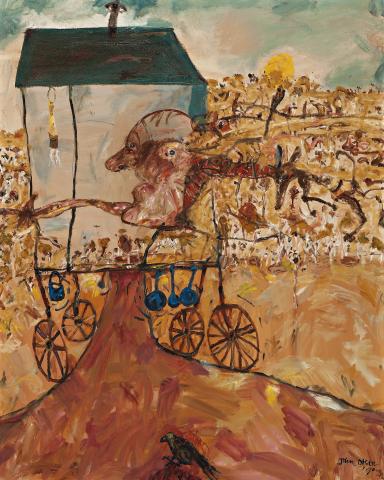SELF PORTRAIT. TRAVELLING WEST, 1990 – 92
JOHN OLSEN
oil on canvas
152.5 x 122.0 cm
signed and dated lower right: John Olsen / ‘90-‘92
signed, dated and inscribed verso on stretcher bar: ‘Self Portrait’ Travelling West’ – John Olsen. 90 [illeg.]
Sherman Galleries, Sydney (label attached verso)
Gene and Brian Sherman collection, Sydney
John Olsen, Australian Galleries, Melbourne, 5 – 23 March 1991, cat. 6 (as ‘Travelling West’)
John Olsen, Sherman Galleries, Sydney, October – November 1993, cat. 6
Hart, D., John Olsen, Craftsman House, Sydney, 2000 (2nd edition), pp. 206 (illus.), 210, 212, 255
Bungey, D., John Olsen An Artist’s Life, Harper Collins, Sydney, 2014, p. 413 (illus. unnumbered plate)
Self Portrait. Travelling West, 1990-92 belongs to an important sub-group within John Olsen’s extensive oeuvre, one which features portraits of great artists ruminating on their own mortality. Olsen started exploring this theme in the mid-1980s beginning with the French painter Edward Degas before moving on to Ian Fairweather, Lloyd Rees and others (including himself). They are difficult works, painted ‘warts and all’, but compelling nonetheless, full of gravitas and foreboding whilst simultaneously suffused with the pulse of life itself. Olsen’s own self portraits are rich with the spirit and colouration of Spain, a country which so affected his early career and which he explored further in subsequent visits in 1985 and 1987. On these latter trips, he renewed his fascination with artists such as Goya, Zurbarán and Picasso and also immersed himself in the writings of revered poet Federico García Lorca. One of the poet’s recurrent themes was the Spanish concept of duende, an almost untranslatable word described by Lorca as being a natural spirit energy which comes ‘blowing insistently over the heads of the dead, in search of new landscapes.’1 Having already lived a fulsome life marked by an alcoholic father, multiple residences, meandering journeys, two marriages and a third in the offering, Lorca’s allusions appealed to the depths of Olsen’s soul-searching.
The poet also adored gypsies ‘the loftiest, most profound and aristocratic element of my country,’2 and Olsen commenced painting their iconic caravans in 1986. These rickety craft were soon peopled with a multitude of celebrated inhabitants, including the poet Robert Graves (Gypsy Caravan I 1989) and Samuel Beckett alongside Francisco Goya (Beckett joins the gypsy caravan 1990). Each person is accompanied by an ‘array of pots, saucepans and other implements … the accumulated baggage of life that one can almost hear clattering and clanking along the road.’3 In Self Portrait. Travelling West, Olsen joins the parade heading west from his home in the Blue Mountains where he had married Katherine Howard in 1989, to a new home and studio in Rydal, near Bathurst. ‘Whilst (Olsen) places himself centre stage in the painting, there is the sense that another force is steering the caravan. This is the ‘consequence’, as John once explained, of following your muse, of handing yourself over to a process of sequencing, of one thing following another. John’s multifaceted view allows us to experience his journey as a frozen moment. A kangaroo bounds across the plain, a lizard streaks across the road, a bird hitches a ride on the rattling caravan, the dry yellowy bush streams past, the road kicks up its red dust – and all converge in the painter as he rushes into the heart of the land.’4
Self Portrait. Travelling West 1990-92 is one of three major Olsen portraits which comprised part of the Gene and Brian Sherman Collection for 25 years. Its powerful predecessor, Donde Voy? Self portraits in moments of doubt, 1989, constituted the artist’s entry to the Archibald Prize that year and has since been promised to the Art Gallery of New South Wales. The third painting, Nolan at Broome, 1990-1992, was sold by Deutscher and Hackett in August 2015.
1. Lorca, F.G., 1933, ‘Theory and Play of the Duende’, quoted in Bungey, D., John Olsen: An Artist’s Life, Harper Collins, Sydney 2014, p. 376
2. Lorca, F.G., quoted in: Hart, D., John Olsen, Craftsman House, Sydney, 2000 (2nd ed.), p. 201
3. Hart, D., op cit, p. 202
4. Bungey, D., op cit., p. 413
ANDREW GAYNOR
